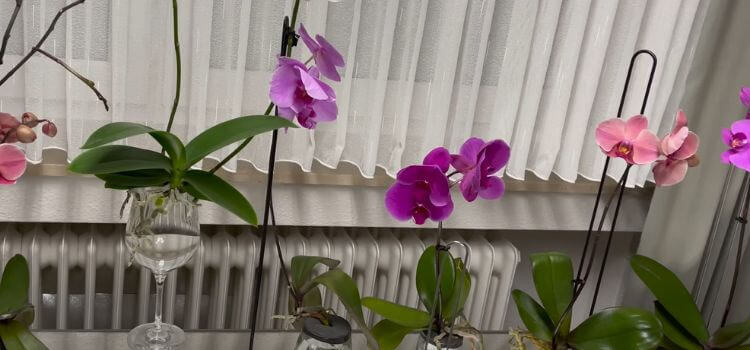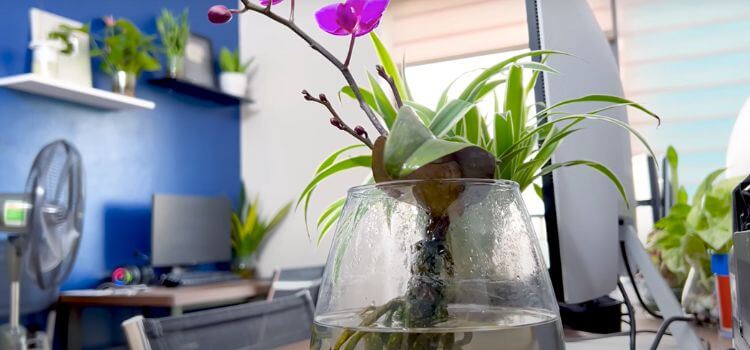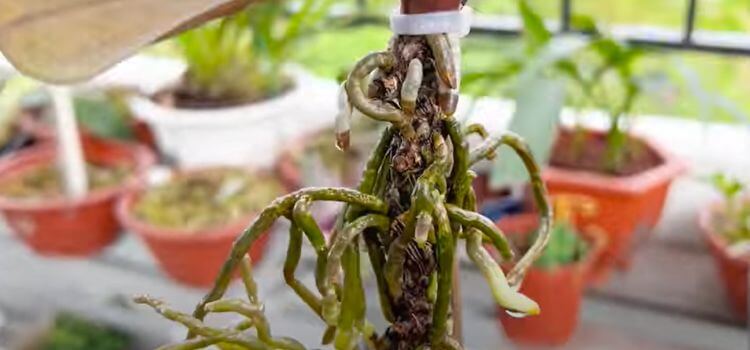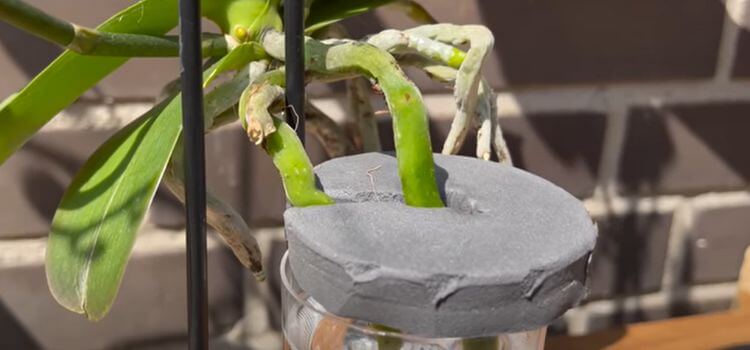As an Amazon Associate, I earn from qualifying purchases.
Grow orchids in water by selecting a transparent vessel and using clean, chlorine-free water. Change the water weekly and ensure the roots are fully submerged without the orchid crowding the container.
Starting an indoor garden and choosing to include orchids can imbue your space with a touch of unfamiliar beauty. Orchids, renowned for their vibrant colours and elegant shapes, have a reputation for being challenging to nurture. Despite this perception, water culture for orchids offers a simplified approach, minimizing the risk of overwatering—a common pitfall for many growers.
This method embraces the orchids’ natural propensity for air and space around their roots, encouraging a healthier growth cycle. Enthusiasts and beginners alike can celebrate the simplicity and effectiveness of water-grown orchids, transforming their admiration into a successful green endeavour.

Choosing The Right Orchids
Growing orchids in water, also known as water culture, brings a modern twist to an ancient art. Orchid enthusiasts are embracing this soil-free approach. But success begins with choosing the right orchids.
Types Of Orchids Suitable For Water Culture
Not all orchids thrive in water culture; selecting the suitable type is crucial. Here are some that often succeed:
- Phalaenopsis – Their robust roots absorb water well.
- Vanda – These cherish high humidity, making them ideal.
- Cattleyas – When adapted slowly, they can prosper.
Considerations When Selecting Orchids
Your role in selecting the right orchids for water culture goes beyond just considering the type. Here’s what you should also take into account:
| Consideration | Details |
|---|---|
| Root Health | Choose orchids with firm, green roots as they adapt better. |
| Plant Size | Smaller plants tend to adjust easier than larger, established ones. |
| Adaptability | Some orchids adapt to changes with ease. Research individual preferences. |
Setting Up Your Water Culture System
Growing orchids in water, an approach known as water culture provides an eye-catching display of roots and simplifies maintenance. To start, setting up the correct system is vital for success. The right container and a well-balanced mix of water and nutrients will ensure your orchids thrive.
Selecting The Appropriate Container
Finding the perfect home for your orchid is key. An ideal container allows roots to spread and thrive. Transparency is crucial as it permits sunlight to reach the roots and will enable you to monitor root health easily.
- Go for glass or plastic: These materials are best as they won’t react with water or nutrients.
- Ensure proper size: The container must accommodate the orchid roots without crowding them.
- Consider openings: Choose a container that makes changing water trouble-free. Ample openings allow for better air circulation.
Choosing The Right Water And Nutrients Mix
Orchid growth depends on the correct balance of water and nutrients. Pure, clean water partnered with specialized nutrients propels healthy growth.
Use distilled or rainwater: Tap water can contain chemicals that harm orchids.
Mix orchid-specific nutrients: Balancing the right nutrients is like giving your orchid a multivitamin. Follow the instructions on orchid food packaging to get it just right.
Change the solution regularly: Refresh water every week to keep nutrients in check and avoid bacterial growth.

Watering And Maintenance
Growing orchids in water adds a twist to traditional orchid care. Delve into the elegant dance of hydration and health, ensuring a burst of colour and longevity for these floating blooms. Right water levels and cleanliness, coupled with timely pruning and repotting cu, cultivate a thriving water orchid display.
Monitoring Water Levels And Quality
- Check water weekly to maintain the right level.
- Use distilled or rainwater to avoid mineral buildup.
- Replace water every 5 to 7 days to keep it clear.
- Observe roots for healthy green and silver hues.
Balanced watering routines prevent root rot and disease, and consistency nurtures vigorous growth. Keep roots submerged, but let them breathe. The water surface should gently kiss the base of the orchid.
Pruning And Repotting Techniques
| Action | Method | Frequency |
|---|---|---|
| Pruning | Snip off dead or yellowing leaves. Trim faded flower spikes. | As needed, after blooming |
| Repotting | Select a wider container. Gently transfer with clean water. | Every two years or when the plant outgrows its space |
Pruning invigorates orchid health and shapes its beauty. Sharp, sterilized scissors protect against infections. Repotting revives the plant’s environment, giving roots new room to expand. Use a clear vessel to monitor root health and water quality at a glance.
Light And Temperature Requirements
Growing orchids in water brings a fresh twist to plant care. Light and temperature are key for healthy growth.
Understanding Orchids’ Light Needs
Orchids thrive with the right light. But too much can harm them. Bright, indirect sunlight works best. Place them near a window, but avoid direct rays. Here’s what they need:
- East-facing windows provide gentle morning light.
- South or West-facing windows might be too intense. Use a sheer curtain for softer light.
- Avoid placing orchids in North-facing windows as they offer little light.
A grow light can supplement if natural light is scarce.
Optimal Temperature Conditions For Water-grown Orchids
Orchids in water still need warmth. A steady temperature keeps them happy. Stick to these guidelines:
| Temperature During Day | Temperature During Night |
|---|---|
| 75°F to 85°F (24°C to 29°C) | 65°F to 75°F (18°C to 24°C) |
Keep orchids away from vents, heaters, or drafts. Sudden changes in temperature can shock them. A stable environment is best for roots to absorb water and nutrients properly.
Common Issues And Troubleshooting
Growing orchids in water can be a rewarding experience. But sometimes problems arise. Here, let’s tackle common issues and find solutions.
Dealing With Root Rot
Root rot often strikes orchids in water. Spotted brown or black roots signal trouble. To solve this, take these steps:
- Remove the plant from water.
- Cut off the rotten roots.
- Clean the healthy roots.
- Rinse the container with a hydrogen peroxide solution.
- Replace the water and return the orchid, avoiding overfilling.

Preventing Mold And Algae
Mould and algae love moist environments. They can harm your water-grown orchids. To prevent them:
| Preventive Action | Benefits |
|---|---|
| Use clear containers | Lets you spot growth early. |
| Change water regularly | Keeps conditions clean. |
| Keep in indirect light | Discourages algae bloom. |
- Change the water every week.
- Scrub the container with soap and water.
- Rinse well to prevent soap residue.
Benefits Of Growing Orchids In Water
Embracing the uniqueness of hydroponics, orchid enthusiasts are now turning to water cultures for their unfamiliar blooms. Growing orchids in water presents a range of beneficial aspects.
Enhanced Nutrient Absorption
Orchids thrive when they absorb what they need. With roots suspended in water, these plants access nutrients directly.
- Better root health becomes apparent swiftly.
- Clear containers make it easy to monitor nutrient levels.
- Adjustments in nutrient concentrations occur in real time.
The result is a personalized feeding regime. It’s all about giving orchids the perfect amount of food to blossom beautifully.
Water Conservation Benefits
Sustainability takes centre stage in water culture. Traditional potting methods often lead to excess water runoff and evaporation.
| Traditional Soil Cultivation | Water Culture Method |
|---|---|
| More water is wasted due to drainage | Less water used over time |
| Frequent watering needed | Water changes only as needed |
By reusing water effectively, orchid growth in water becomes a green thumbs-up. Not to mention, it’s a step forward in eco-friendly gardening practices.

Frequently Asked Questions
Yes, orchids can grow in water using a method called water culture, where their roots are submerged in water periodically or continuously.
Immerse an orchid in water for 5-15 minutes, ensuring the roots are fully submerged. Remove the plant after this period to prevent overwatering.
Orchids should not sit in water, as prolonged soaking can lead to root rot. Always drain excess water to prevent this issue.
To keep orchids fresh in water, first provide a clean vase with distilled water. Trim their stems diagonally before submerging. Change the water every 2-3 days, keeping it lukewarm to prolong bloom freshness. Avoid direct sunlight and maintain a consistent room temperature.
Conclusion
Growing orchids in water offers a beautiful, low-maintenance alternative to traditional soil-based cultivation. Embrace this method to enjoy the serene beauty of aerial roots and stunning blooms. Start your hydroponic orchid journey and witness the simplicity and rewards it brings to your indoor gardening experience.

